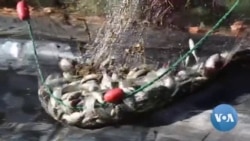Kenya's nomadic herders are among those suffering the most from recurring drought that kills the livestock on which they depend. To make them less dependent on rain, aid programs are teaching herders how to farm fish and keep bees.
Makay Mamo, 39, feeds the tilapia fish in her pond, in Kinna ward, Isiolo county, Kenya. For the last two years, she has been raising fish on her farm, a break from the community’s pastoral lifestyle.
This change has served her well. As the county deals with a devastating drought that threatens the lives of 2 million people, she has food on her table and surplus for the market.
During the drought, she says, people can’t buy food in the market and all the goats are too thin. But with fish, she says, it’s different. Fish only need the pond water, she says, so catching a big fish lets people feed their families.
The idea was introduced to Isiolo, a county in the northern part of Kenya, in 2019 by the county government in collaboration with the World Food Program.
The initiative is meant to cushion residents from the effects of extreme weather conditions like droughts and floods.
“We started off with general interventions like food distributions which was a bit reactionary,” says Irene Opwora, WFP’S field officer in Isiolo. “Like after a drought or flood, we were giving food to communities, but we then realized that over time that it was not sustainable.”
The sustainable food systems program has seen pastoralists try other types of farming aside from livestock.
Fish farmers like Makay have tanks that store water pumped from rivers or wells. When it rains, they save the rainwater and store it for the ponds.
The county government of Isiolo says diversifying sources of livelihood has helped lessen the impact of droughts that hit the county and surrounding areas every few years.
Amina Bachi, a fisheries officer in Isiolo county, says the county is determined to get more farmers on board.
“Right now, I can say we have a good number of people accepting fish as a livelihood and they are using it to earn other income to produce other household needs, so we, right now we have phase two that’s coming in,” Bachi says. “We are targeting 40 fish farmers. We are hoping that with time, they’ll be able to see fish as other livestock.”
The program has grown from 15 groups to more than 50. And individual farmers now farm and consume the fish, as well practice crop farming, hay production and bee keeping.
The program aims to reach close to 1,000 groups in the next five years.










